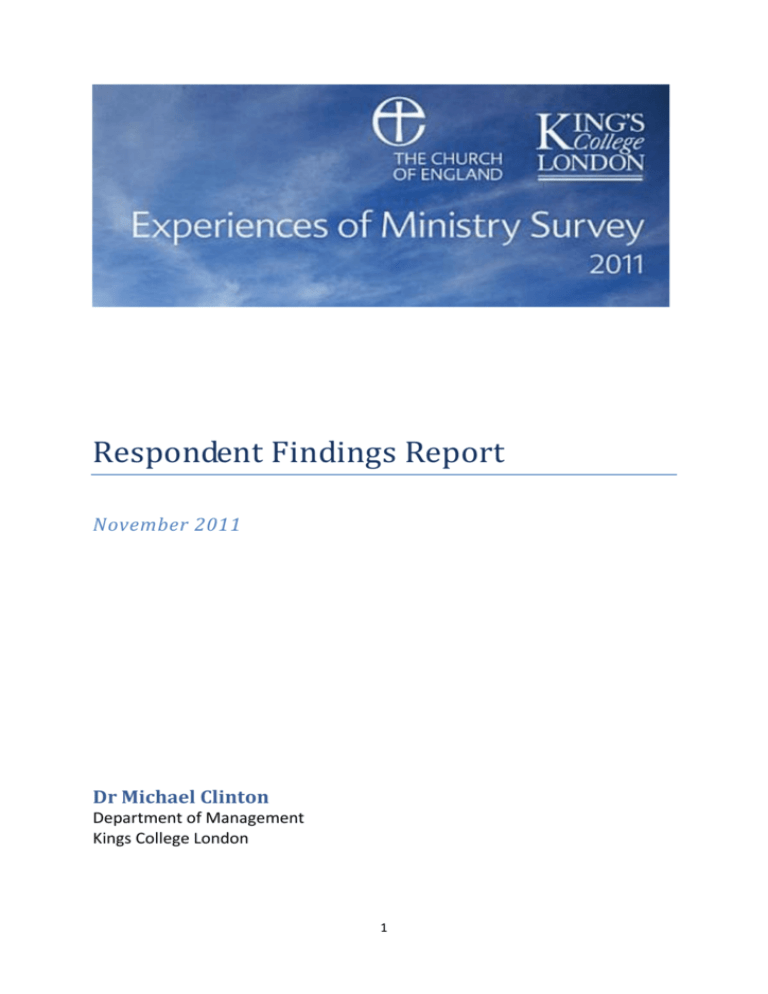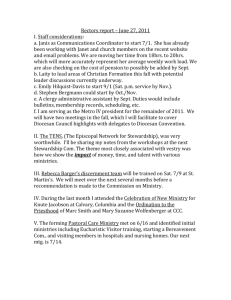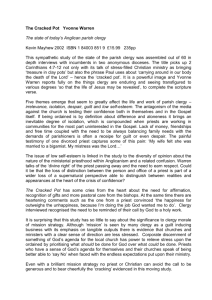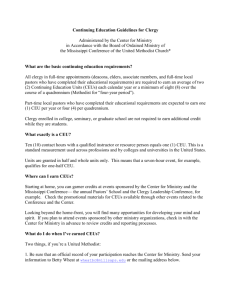Findings Report 2011 - The Church of England
advertisement

Respondent Findings Report November 2011 Dr Michael Clinton Department of Management Kings College London 1 Contents 1. Introduction to the Experiences of Ministry Survey.................................. 4 2. The 2011 Survey....................................................................................... 5 3. Findings of 2011 Survey ........................................................................... 5 Engagement....................................................................................................5 Burnout ..........................................................................................................6 Workload ........................................................................................................7 Perceptions of the Diocese .............................................................................8 Growth ...........................................................................................................8 4. Conclusions of 2011 Survey.................................................................... 10 2 Preface This brief report sets out the headline findings of the 2011 Experiences of Ministry Survey. It would not have been possible to produce without the participation of survey respondents, the preliminary work of the advisory group and ongoing analysis conducted by Dr Mike Clinton. Thank you to all. This work is part of an ongoing process of research and consultation. Initial findings have already been reported to the Ministry Council and are informing consultations with Bishops and Directors of Ministry. In addition, Mike Clinton and I will be presenting the research at the 2012 Faith in Research Conference. In reporting the work, care has been taken to note the preliminary nature of the findings. In the report Mike rightly describes the ‘chicken and egg’ problem of what factors come first in the relationships examined. These will become clearer over time. However, in the short term the big picture is a positive one and is summed up by one of the survey’s respondents when they write: “Ministry is exhausting, non-stop and demanding; but how much of the workload is self generated? I do enjoy it, love the parish and the people and am hugely encouraged at the growth the church has seen over the past few years.” There is much still to learn about what will sustain and energise clergy in a future that promises to be demanding as ever. This report, and the ongoing research that underpins it, is an important contribution to that learning. Dr Tim Ling National Adviser, Continuing Ministerial Development Ministry Division, Archbishops’ Council 3 1. Introduction to the Experiences of Ministry Survey The Experiences of Ministry Survey (EMS) is a five-year process of research and consultation that aims to find out what sustains clergy for a ministry that for many will encompass many different settings over several decades. This project seeks to inform national strategies for supporting ministry and to shape the future emphasis of continuing ministerial education and development by asking clergy to share their personal experiences and views. The EMS is an independent piece of research conducted by Dr Mike Clinton, a Lecturer in Work Psychology and Human Resources Management at Kings College London. The project has been supported by Dr Tim Ling, National Adviser for Continuing Ministerial Development, and an Advisory Group of national clergy. There will be three online surveys between 2011 and 2015. The aim is to collect data on a nationally representative sample of clergy at each time-point, but also to follow a representative sample of clergy across these time-points to better understand how their experiences change and the effects these changes have. The survey covers attitudes and feelings relating to clergy’s day-to-day role, their diocese, spiritual and numerical growth and health and well-being. The research draws on the Demands-Resources model of “Work Engagement” in its theoretical underpinning (e.g. Schaufeli & Bakker, 20101). Engagement is a persistent, positive and fulfilling psychological state that is characterised by vigour (high energy, willingness and persistence), dedication (involvement, enthusiasm and pride), and absorption (fully concentrated and engrossed in one’s work). There is a general agreement that ‘being engaged’ is a uniformly positive and desirable state to be in, positively affecting one’s ability to perform well, how one feels and one’s well-being. It is suggested that people’s engagement can be influenced by the interaction of demands and resources within a particular role. Demands may be physical, mental, emotional, social, or organisational. Resources can include individual characteristics, such as beliefs of self-efficacy and a proactive personality, aspects of the role, including autonomy and feedback, as well as support structures and appropriate learning opportunities. Ethical approval for Experiences of Ministry Survey was granted by a KCL Ethics Panel (ref: REP(EM)/10/11-52). For more information, please visit: www.experiencesofministry.org 1 In Bakker, A & Leiter, M (2010). Work engagement: A handbook of essential theory & research. Psychology Press; NY, NY. 4 2. The 2011 Survey The EMS questionnaire contains questions that seek to understand a range of issues that are thought to be relevant to the experience of ministry and to influence clergy engagement. Some of the questions are standard, academically validated measures of established psychological constructs. Other bespoke questions were developed especially for the survey. The content of the questionnaire was informed by an Advisory Group of national clergy and underwent pilot work to further enhance the relevance and comprehension of the questions within. Feedback from a minority of participants, particularly retired clergy and some exceptional groups, indicates that some found the survey difficult to complete or requested additional or more refined questions. In total, 2916 responses were received to the 2011 survey from representatives of each of the 44 Church of England dioceses and beyond. For this report, all clergy from non-English dioceses, who formed a sizable subsample, were removed from the dataset. However it is hoped that this group will be the focus of analysis in the near future. Just over half of the people who responded were stipendiary ministers. Responses were received from clergy in a wide range of roles and settings. The majority of the sample were married, male and white (British). Slightly less than half had dependent relatives or children. The average age of the sample was 56 years (min=26yrs, max=90yrs). 3. Findings of 2011 Survey A selection of the findings to the survey are presented below: Engagement • Overall, clergy reports of engagement were high and compared well with benchmarked data from other occupational groups. • As shown in Figure 1, responses to the engagement questions were resoundingly positive. However, there is still evidence of a small but important group of clergy who are engaged to a lesser degree or feel engaged less frequently than others. 5 Figure 1. Responses to an engagement question • Those reporting highest levels of engagement were most likely to be high in self efficacy (confidence), have a more proactive personality, have been ordained more recently, and have an intellectually challenging role in which they receive useful feedback on how well they are performing and are relatively free to make decisions. Overall, attitudes relating to the diocese and demographic factors played a very minor role in explaining levels of clergy engagement. Burnout • Clergy burnout was assessed by measuring levels of emotional exhaustion and depersonalisation (i.e. treating other people as if objects) using standardised questions. Again benchmarking data indicates that clergy are not high in terms of burnout when compared with other occupational groups. See the range of answers to a burnout question in Figure 2. Figure 2. Responses to an indicative burnout question 6 • Further findings indicated that younger clergy were most at risk from burnout, as were those with lower self-efficacy, clergy who received less support from colleagues and their diocese, those with emotionally and physically demanding roles in which feedback was low, and those unable to mentally detach after a day’s ministry. Workload • Workloads and the amount of time spent on various activities clearly vary across different ministerial roles. Table 1 presents the typical number of hours a week ministers in different roles spend engaged in eleven different activities. Engaged in liturgical duties (e.g. Preparing/presiding at services) Participation in corporate & individual prayer Fund raising Enacting legal responsibilities (e.g. CRB checks) Administration and organisation Exercising pastoral ministry (e.g. in crisis and in regular pastoral care) Conducting and preparing for occasional offices (e.g. baptisms) Leadership role in local community Working with colleagues (supportively, collaboratively or leading) Travelling time to and from worship centres Stipendiary Minister Part-time Stipendiary Minister Self-supporting Minister Ordained Local Minister Preaching/teaching (including preparation) Table 1. Average time spent on different ministerial activities during previous week Hours per week Hours per week Hours per week Hours per week Hours per week Hours per week Hours per week Hours per week Hours per week Hours per week Hours per week 6.0 6.1 5.3 1.2 .6 8.7 5.1 3.4 3.0 4.4 1.5 5.7 5.3 4.9 .8 .6 6.2 3.9 3.0 1.7 1.9 1.5 5.3 4.2 5.0 .8 .2 2.8 3.3 1.9 2.7 3.6 1.6 5.8 4.5 5.8 1.0 .2 3.0 3.2 2.0 1.6 3.1 1.2 House-for-Duty 5.6 5.6 4.9 1.1 .5 4.8 4.4 2.9 1.7 2.3 .9 House-for-Duty (active retired) 6.4 6.9 3.9 1.6 .4 4.9 3.8 3.3 2.2 1.6 1.5 Chaplain 5.4 3.6 4.6 .3 .6 8.5 11.2 1.5 4.9 9.3 2.4 Minister in secular employment 3.8 3.1 4.9 .6 .2 3.5 3.0 .8 5.7 7.4 1.7 Dual role post 5.4 4.2 4.9 .6 .4 6.5 5.2 2.1 2.9 4.9 1.5 Active retired 4.1 3.0 4.3 .2 .1 1.4 2.0 1.2 1.0 1.5 1.2 Retired 3.4 2.2 4.1 .3 .0 .7 1.4 .7 .8 1.0 .6 • It is common for clergy to take one day off a week most of the time. However, for some this is a rarity with ministers in secular employment least likely to take a day off a week. 7 Perceptions of the Diocese • Reports of perceived support from the diocese were moderate; as were reports of the perceived fairness of decision-making within dioceses. Levels of perceived support are fairly average in comparison to levels reported by other samples of occupational groups and compare favourably to those found in the health sector. Further analyses also suggest that perceptions of the diocese do not play a large role in shaping clergy’s experiences of ministry. Growth • A number of questions sought to examine perceptions of spiritual and numerical growth amongst those respondents surveyed. But first, the survey asked about the context of ministry, for example does it have a primary context or multiple contexts? 29% of respondents reported that they had too many foci of ministry to be able to answer the questions and did not report on perceptions of growth. • The spiritual growth questions referred to aspects of relationships (with God, self and others), discernment of what might be ‘of God’ in life and faithfulness to the paschal mystery. As shown in Figure 3, for clergy who felt they could discern each of these three facets, the vast majority reported positive changes to each. • The numerical growth questions referred to weekly attendance patterns of congregations, new vocations to licensed ministry and disciples and discipleship. Figure 3 also shows that clergy who responded to the survey are broadly positive regarding numerical growth in each facet; indeed, decreases in each were not commonly reported. 8 Figure 3. Reports of spiritual and numerical growth • Turning to what might be driving spiritual and numerical growth, further analyses revealed an important association between the running of nurture courses and both forms of growth; growth is stronger when nurture courses are more frequently run. It was also found that more engaged clergy reported stronger growth overall, as did those who reported receiving more useful feedback about how well they were performing in their role. 9 4. Conclusions of 2011 Survey The level of response to this survey was very encouraging, as were the large number of positive messages received regarding this research. The survey has uncovered a great many interesting findings and perhaps shows a more optimistic picture of the experiences of ministry than many would have previously thought. Larger and more detailed reports have been produced to help support decision-making regarding national strategies for supporting ministerial education and development and it is hoped that the survey data collected from almost 3,000 clergy can be of use in answering a range of policy questions over the coming years and become the subject of publication. At present, our knowledge from the survey suffers a little from a ‘chicken or egg’ problem in terms of not having a clear idea about what factors really come first in the relationships examined (i.e. an issue of causation). But the future work planned for 2013 and 2015 will seek to unravel such issues and we hope that if you participated in the 2011 survey, you might continue to support this research. Alternatively, if you were unable to participate this time round we hope that now you have seen the fruits of the survey, you might be keen to do so in 2013 and beyond. Thank you to all who participated. Dr Michael Clinton Department of Management Kings College London Details of the 2012 Faith in Research Conference will shortly be posted at: http://www.churchofengland.org/about-us/facts-stats/research-statistics.aspx 10






